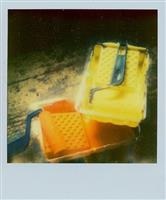A Paint Primer for Your Interior DIY Project
by Dawn Smith

Applying fresh paint is one of the best ways to spruce up a home for sale or to update the look in your current space. Painting is inexpensive and provides instant gratification. Some people even enjoy the soothing application process! Planning and preparation are the keys to a perfect paint job. Although small projects can be done in a weekend, give yourself at least two to split the prep and application time.
Most people jump right in and are excited by the process of paint shopping for the new color. Envisioning a new hue in the home is a great motivator to get into the store and investigate the vast world of wall color. Do take time to choose several paint chips and apply small samples at home. Paint color shifts throughout the light of day and evening. It’s best to live with a small section of paint on the wall for a few days to see if its appearance is pleasing.
Photo Credit
Which type of paint do I choose?
-
Latex paint is water-based, which means it’s easy to use and easy to clean up. It dries quickly and in general, can be used throughout homes. The sheen of latex paint varies. High gloss is highly stain-resistant and cleanable, but it does show imperfections easily. Semi-gloss paints work well on trim where scuffs are visible.
Tip: Expect to paint at least two coats. Deep or very saturated colors such as red will require more. A tinted primer may also be helpful. A high-quality paint will cost $20.00 to $35.00 per gallon, which will cover about 400 square feet. Don’t forget to store a quart to half-gallon of touch-up paint for future use.
What tools do I need to paint?
-
Brushes have either synthetic or natural bristles. Natural bristle brushes are typically used for oil-based paint, shellacs, and polyurethane finishes. Synthetic brushes are durable and are made to be reusable with proper cleaning care. They are also less expensive.
-
The brush size depends on its job. One- to two-inch angled brushes are designed for windows, corners, and small trim. Three-inch brushes typically handle cabinets and doors well. Four-inch square brushes cover flat surfaces evenly.
Tip: Paint edgers are pad applicators that will follow straight lines without tape. Extendable painter’s rods are useful for ceilings and for painting walls without ladders.
How do I prepare surfaces for painting?
-
The cleanliness and smoothness of a wall help paint appear professionally applied. Dust, cracks, and holes will ruin a perfect layer of paint. Depending on the condition of the existing paint, walls may need to be scraped, then sanded.
-
Use large sponges to gently wipe down walls with mild soap. The paint clings to clean surfaces better.
-
Remove wall plates and doors. It is possible to paint a door on its hinges, but professionals remove and paint them standing horizontally for the best application.
-
If you are a novice painter or have an unsteady hand, painter’s tape will offer straight lines and separate trim from walls easily. To ensure a clean line without lifting the paint from the wall, score the tape for removal.
-
Clean the room of everything possible. Accidents always happen. The more workspace to navigate, the better. Corral unmovable objects such as a bed into the center of the room and cover with a heavy-duty drop cloth to avoid paint splatter and drywall dust.
Tip: 5-in-1 tools allow users to open paint cans, spackle wall cracks, and scrape and clean rollers.
How do I apply paint?
-
There are two major techniques to tackle a room. Some people "cut in" (only painting the intended surface, not the surface adjacent-trim, ceiling, or corners) first either with painter's tape or freestyle. Walls are finished with a roller when the trim is dried.
-
Others prefer the top-down method: Ceiling, crown molding, walls, windows, doors, and baseboards last. This technique inhibits dust and dirt from the floor from invading clean paint after baseboards are finished.
-
Lightly load rollers for better application control. Tapping excess paint back into the bucket decreases dripping.
-
For walls, keep wet edges working and apply in approximately three-foot sections with long and continuous passes.
-
Always apply two coats and try to work on days with low humidity. The paint will dry faster.
Tip: Windows requires detailed control. Paint them early in the day before becoming tired.
Military families often paint as one of their first projects in a new home. Carefully preparing for a painting project will ultimately yield the best outcomes for a DIY painter. This guide and other decorating suggestions are found in MilitaryByOwner’s Resources tab.